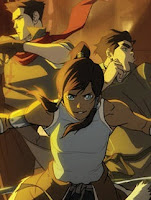My News and Reviews
I managed to post the most recent Library Love was last week. Similar in format to my weekly quick takes, I’m trying to feature Library Love posts on a bi-monthly schedule, so you can look forward to the next one sometime in September. I also posted my first in-depth manga review for the month, Shigeru Mizuki’s semi-autobiographical work NonNonBa. It’s a lovely tribute to the woman who inspired his love of yokai. And speaking of Shigeru Mizuki! Another of his semi-autobiographical manga, Onward Towards Our Noble Deaths, was honored with the 2012 Eisner Award for Best U.S. Edition of International Material—Asia! Also, Katsuhiro Otomo was inducted into the Eisner Award Hall of Fame.
On to a couple of interesting things I came across online! Over at the Maga UK Anime blog, Helen McCarthy (author of The Art of Osamu Tezuka) has a great article looking at Monkey from The Journey to the West (which I finished reading relatively recently) and his appearances in Japanese film, manga, and anime—Monkeying Around. Library Journal has an interview with Prison Librarian Philip Ephraim on the Positive Effects of Comics. Manga is particularly popular at the prison where he works. Over the weekend PictureBox announced a very exciting license. Currently scheduled for next spring, I’m looking forward to the release of The Passion of Gengoroh Tagame: The Master of Bara Manga a great deal. I am absolutely thrilled to see bara being licensed in English. And finally, don’t forget about the upcoming Clamp Manga Moveable Feast which begins next Monday!
Quick Takes
 Bónd(z) by Tōko Kawai. Bónd(z) collects four of Kawai’s boys’ love shorts: “[bónd(z)],” “Situation,” “Kitan Garden,” and “Sakura.” Despite being part of Digital Manga’s 801 imprint, Bónd(z) is actually fairly tame when it comes to graphic sexual content; the most explicit probably being a genital piercing. The first two stories in the collection were my favorite. Coincidentally, they both involved a pair of best friends coming to terms with the fact that their relationship is more than just that. However, Kawai takes two very different approaches with the stories. “Kitan Garden” is a fluffy and somewhat unusual fantasy. “Sakura” is the oldest work and the least accomplished, but it still has its moments.
Bónd(z) by Tōko Kawai. Bónd(z) collects four of Kawai’s boys’ love shorts: “[bónd(z)],” “Situation,” “Kitan Garden,” and “Sakura.” Despite being part of Digital Manga’s 801 imprint, Bónd(z) is actually fairly tame when it comes to graphic sexual content; the most explicit probably being a genital piercing. The first two stories in the collection were my favorite. Coincidentally, they both involved a pair of best friends coming to terms with the fact that their relationship is more than just that. However, Kawai takes two very different approaches with the stories. “Kitan Garden” is a fluffy and somewhat unusual fantasy. “Sakura” is the oldest work and the least accomplished, but it still has its moments.
 Get Jiro! written by Anthony Bourdain and Joel Rose and illustrated by Langdon Foss. I was both a little hesitant and excited when I learned about Get Jiro! Ultimately I decided to give it a try, and I’m glad that I did. Although not without its problems—several plot elements are rushed or not entirely developed, particularly during the story’s climax—Get Jiro! is great, violent, bloody fun. (There’s even a nod to Akira in there.) Jiro is a phenomenal, and deadly, sushi master who isn’t about to let the other chefs-cum-crime lords in a future Los Angeles boss him around. Get Jiro! takes foodie culture to absurd extremes and has a great potential to offend some readers along the way if they would decide to take the comic too seriously. I had a blast reading it, though.
Get Jiro! written by Anthony Bourdain and Joel Rose and illustrated by Langdon Foss. I was both a little hesitant and excited when I learned about Get Jiro! Ultimately I decided to give it a try, and I’m glad that I did. Although not without its problems—several plot elements are rushed or not entirely developed, particularly during the story’s climax—Get Jiro! is great, violent, bloody fun. (There’s even a nod to Akira in there.) Jiro is a phenomenal, and deadly, sushi master who isn’t about to let the other chefs-cum-crime lords in a future Los Angeles boss him around. Get Jiro! takes foodie culture to absurd extremes and has a great potential to offend some readers along the way if they would decide to take the comic too seriously. I had a blast reading it, though.
 Hikaru no Go, Volumes 21-23 written by Yumi Hotta and illustrated by Takeshi Obata. Everything that takes place after the seventeenth volume of Hikaru no Go seems to me more like an extended epilogue rather than a part of the main story. However, these final volumes do provide a satisfying conclusion to the series as a whole. I respect that Hotta dared to take a more realistic approach to the ending instead of taking an easier way out. Even if you have no interest in or knowledge of go, I do recommend giving Hikaru no Go a chance. It’s a great series. The characters are so enthusiastic that I found myself easily swept up in their excitement about go and their struggles to become the best players they can.
Hikaru no Go, Volumes 21-23 written by Yumi Hotta and illustrated by Takeshi Obata. Everything that takes place after the seventeenth volume of Hikaru no Go seems to me more like an extended epilogue rather than a part of the main story. However, these final volumes do provide a satisfying conclusion to the series as a whole. I respect that Hotta dared to take a more realistic approach to the ending instead of taking an easier way out. Even if you have no interest in or knowledge of go, I do recommend giving Hikaru no Go a chance. It’s a great series. The characters are so enthusiastic that I found myself easily swept up in their excitement about go and their struggles to become the best players they can.
 Olympos by Aki. I was fairly obsessed with Greek mythology in high school, so I was looking forward to reading the omnibus edition of Olympos. The manga isn’t a strict retelling of any of the Greek myths; instead, Aki primarily uses the various gods and settings to create her own tale. Unfortunately, it ends up being too lofty and semi-philosophical for its own good. Occasionally, something interesting or thought-provoking would catch my attention, but for the most part I wasn’t engaged enough that I wanted to make the effort to follow the characters’ circular conversations. However, Aki does nail the capricious natures of the gods and her artwork is gorgeous. Yen Press’ attention to the physical production and quality of the manga makes for a beautiful volume.
Olympos by Aki. I was fairly obsessed with Greek mythology in high school, so I was looking forward to reading the omnibus edition of Olympos. The manga isn’t a strict retelling of any of the Greek myths; instead, Aki primarily uses the various gods and settings to create her own tale. Unfortunately, it ends up being too lofty and semi-philosophical for its own good. Occasionally, something interesting or thought-provoking would catch my attention, but for the most part I wasn’t engaged enough that I wanted to make the effort to follow the characters’ circular conversations. However, Aki does nail the capricious natures of the gods and her artwork is gorgeous. Yen Press’ attention to the physical production and quality of the manga makes for a beautiful volume.
 The Legend of Korra, Episodes 1-12 created by Michael Dante DiMartino and Bryan Konietzko. I am a huge fan of Avatar: The Last Airbender. I was very excited when I heard that the creators were returning to that world with The Legend of Korra, taking place about seventy years later. Except for the last five minutes or so of the last episode and a couple of casting choices, I was not disappointed with the new series. I particularly enjoyed the updated setting which shows evolution not only in technology but in bending as well. The Legend of Korra is readily accessible to those who never saw its predecessor, but those who have will appreciate some of the nods and references made to it.
The Legend of Korra, Episodes 1-12 created by Michael Dante DiMartino and Bryan Konietzko. I am a huge fan of Avatar: The Last Airbender. I was very excited when I heard that the creators were returning to that world with The Legend of Korra, taking place about seventy years later. Except for the last five minutes or so of the last episode and a couple of casting choices, I was not disappointed with the new series. I particularly enjoyed the updated setting which shows evolution not only in technology but in bending as well. The Legend of Korra is readily accessible to those who never saw its predecessor, but those who have will appreciate some of the nods and references made to it.
 Tsuritama directed by Kenji Nakamura. Local legends, social anxiety, fishing, and aliens—an odd combination that Tsuritama somehow manages to make work. The first half of the series is a coming-of-age story while the second half spins off into a hunt for aliens. From the very beginning Tsuritama was a strange series, so the shift in direction actually flows pretty well. Some of the quirkiness did seem a bit forced—a few plot and design elements are outlandish without much justification—but I enjoyed Tsuritama immensely. I couldn’t help but watch it with a grin on my face. Visually, the series is a treat with great animation and an appealing style. The story being told can be a bit silly (which I don’t at all consider a bad thing) and Tsuritama looks good doing it.
Tsuritama directed by Kenji Nakamura. Local legends, social anxiety, fishing, and aliens—an odd combination that Tsuritama somehow manages to make work. The first half of the series is a coming-of-age story while the second half spins off into a hunt for aliens. From the very beginning Tsuritama was a strange series, so the shift in direction actually flows pretty well. Some of the quirkiness did seem a bit forced—a few plot and design elements are outlandish without much justification—but I enjoyed Tsuritama immensely. I couldn’t help but watch it with a grin on my face. Visually, the series is a treat with great animation and an appealing style. The story being told can be a bit silly (which I don’t at all consider a bad thing) and Tsuritama looks good doing it.













